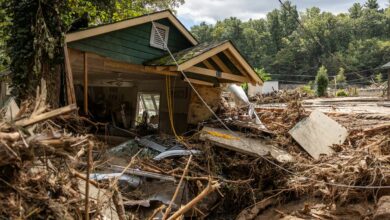
As many as 8,000 people in and around the city of Georgetown, South Carolina, have been urged to evacuate ahead severe flooding expected this week from two rain-gorged rivers in what may be the final destructive chapter of Hurricane Florence.
Floodwaters of 5 to 10 feet (1.5 to 3 m) are expected to inundate Georgetown and surrounding communities by late this week as the Pee Dee and Waccamaw rivers overrun their banks along the low-lying tidal flats where they converge at Winyah Bay, which flows into the Atlantic.
Emergency management officials began sending pre-recorded telephone messages to residents in harm’s way over the weekend, and will probably start going door-to-door in the next few days, Georgetown County spokeswoman Jackie Broach-Akers said.
The potential flood zone encompasses some 3,500 homes in Georgetown, which lies at the confluence of the two rivers at the top of the bay, and the coastal resort community of Pawleys Island, she told Reuters.
She said the estimated 6,000 to 8,000 people who live in that area are being “strongly urged”, to leave on their own, although no mandatory evacuation has been ordered.
The county plans to open emergency shelters at 7 a.m. on Monday, and hotels outside the flood zone in nearby Myrtle Beach are offering discounts for evacuees. Public schools will be closed until further notice, Broach-Akers said.
State transportation crews were working to erect temporary dams on either side of US Highway 17, the main coastal route through the area, and National Guard engineers were installing a floating bridge at Georgetown in case the highway is washed out at the river.
“The water is still rising there,” said Bob Oravec, a meteorologist with the National Weather Service’s Weather Prediction Center. “It’s a matter of time before it subsides,” he said early on Monday.
High water
About 100 miles (160 km) up the coast, a commercial section of downtown Wilmington, North Carolina, by the Cape Fear River was under a foot of water, with flooding expected to rise by a further 2 feet with high tide on Sunday evening, city spokesman Dylan Lee said.
Flooding in Wilmington was expected to peak on Monday along the city’s Water Street riverfront, where many businesses had stacked sandbags in advance, Lee said. But the city said its offices would reopen on Monday after having been closed for a week.
Nine days after Florence came ashore, the National Weather Service said flooding would likely persist in coastal parts of the Carolinas for days as the high-water crest of numerous rivers keeps moving downstream toward the ocean.
“This isn’t over,” said Oravec. “All that water is going to take a good while to recede,” he said. “Damage can still be done. It’ll be a slow drop.”
The storm dumped 30 to 40 inches (75 to 100 cm) of rain on the Wilmington area alone after making landfall nearby on Sept. 14.
Floodwaters have begun to recede farther inland.
That left hundreds of dead fish stranded on a highway near Wallace, about 35 miles from the nearest beach, according to the Penderlea Fire Department, which posted video of firefighters hosing the fish off Interstate 40.
“Well, we can add ‘washing fish off of the interstate’ to the long list of interesting things firefighters get to experience!” the department said on Facebook.
Remnants of the once-mighty storm brought heavy rains across a swath of the country, prompting flood watches and warnings from Texas to Virginia and Maryland, at least through Monday, the weather service said.
About 5,000 people across North Carolina have been rescued by boat or helicopter since the storm made landfall, twice as many as in Hurricane Matthew two years ago, according to state officials. Thousands of people remained in shelters.




